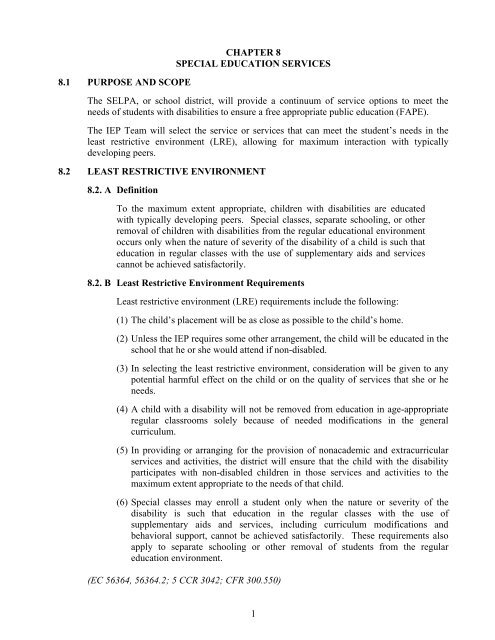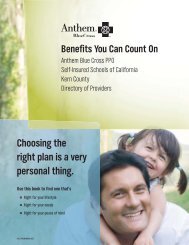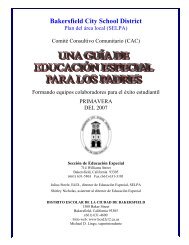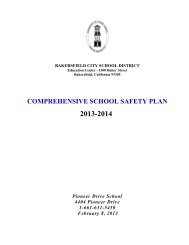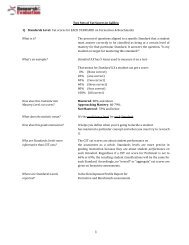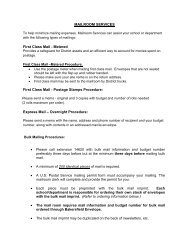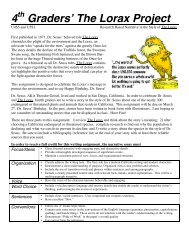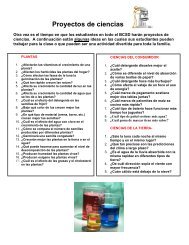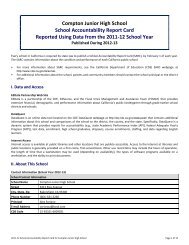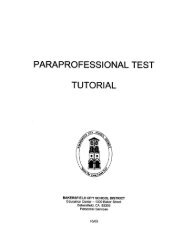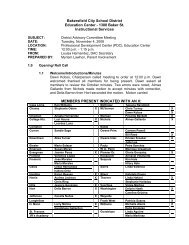CHAPTER 8 - BCSD Static Server - Bakersfield City School District
CHAPTER 8 - BCSD Static Server - Bakersfield City School District
CHAPTER 8 - BCSD Static Server - Bakersfield City School District
You also want an ePaper? Increase the reach of your titles
YUMPU automatically turns print PDFs into web optimized ePapers that Google loves.
8.1 PURPOSE AND SCOPE<br />
<strong>CHAPTER</strong> 8<br />
SPECIAL EDUCATION SERVICES<br />
The SELPA, or school district, will provide a continuum of service options to meet the<br />
needs of students with disabilities to ensure a free appropriate public education (FAPE).<br />
The IEP Team will select the service or services that can meet the student’s needs in the<br />
least restrictive environment (LRE), allowing for maximum interaction with typically<br />
developing peers.<br />
8.2 LEAST RESTRICTIVE ENVIRONMENT<br />
8.2. A Definition<br />
To the maximum extent appropriate, children with disabilities are educated<br />
with typically developing peers. Special classes, separate schooling, or other<br />
removal of children with disabilities from the regular educational environment<br />
occurs only when the nature of severity of the disability of a child is such that<br />
education in regular classes with the use of supplementary aids and services<br />
cannot be achieved satisfactorily.<br />
8.2. B Least Restrictive Environment Requirements<br />
Least restrictive environment (LRE) requirements include the following:<br />
(1) The child’s placement will be as close as possible to the child’s home.<br />
(2) Unless the IEP requires some other arrangement, the child will be educated in the<br />
school that he or she would attend if non-disabled.<br />
(3) In selecting the least restrictive environment, consideration will be given to any<br />
potential harmful effect on the child or on the quality of services that she or he<br />
needs.<br />
(4) A child with a disability will not be removed from education in age-appropriate<br />
regular classrooms solely because of needed modifications in the general<br />
curriculum.<br />
(5) In providing or arranging for the provision of nonacademic and extracurricular<br />
services and activities, the district will ensure that the child with the disability<br />
participates with non-disabled children in those services and activities to the<br />
maximum extent appropriate to the needs of that child.<br />
(6) Special classes may enroll a student only when the nature or severity of the<br />
disability is such that education in the regular classes with the use of<br />
supplementary aids and services, including curriculum modifications and<br />
behavioral support, cannot be achieved satisfactorily. These requirements also<br />
apply to separate schooling or other removal of students from the regular<br />
education environment.<br />
(EC 56364, 56364.2; 5 CCR 3042; CFR 300.550)<br />
1
8.3 CONTINUUM OF SERVICE OPTIONS<br />
The continuum of options includes, but is not necessarily limited to, all of the following or<br />
any combination of the following:<br />
a) Regular education programs with specially designed modifications.<br />
b) Regular education classroom with resource specialist services.<br />
c) Regular education classroom with related services.<br />
d) Regular education classroom with services from a special day class teacher and supports<br />
and/or related services.<br />
8.3. A Special Classes and Centers<br />
Instruction in settings other than classrooms where specially designed instruction<br />
may occur.<br />
Itinerant instruction in classrooms, resource rooms, and settings other than<br />
classrooms where specially designed.<br />
Instruction using telecommunication and instruction in the home, in hospitals, and in<br />
other institutions.<br />
8.3. B Nonpublic, Nonsectarian <strong>School</strong> Services.<br />
“Nonpublic, nonsectarian school” means a private, nonsectarian school that enrolls<br />
individuals with exceptional needs pursuant to an individualized education program<br />
and is certified by the CDE.<br />
8.3. C State Special <strong>School</strong>s.<br />
In determining the educational placement of a child with a disability, including a<br />
preschool child, the district will ensure that the placement decision is made by a<br />
group of persons, including the parents, and other persons knowledgeable about the<br />
child, the meaning of the evaluation data, and the placement options.<br />
All placement decisions will be based on the individual need of the student pursuant<br />
to the IEP and not on the basis of the disability, configuration of service delivery,<br />
availability of staff, curriculum intent or administrative experience. All placements<br />
will be made in the least restrictive environment.<br />
(EC 56360, 56361; CFR 300.551, 300.26)<br />
8.3. D Related Services (EC 56363)<br />
Related services as specified in the IEP shall be available, when the instruction and<br />
services are necessary for the student to benefit educationally from his or her special<br />
2
education program. These services may include, but are not limited to, the<br />
following:<br />
Language and Speech Development and Remediation (CCR 3051.1)<br />
The related service in language speech and hearing may include:<br />
(1) Specialized instruction and services for students with disorders of language,<br />
speech and/or hearing, including monitoring of student progress on a regular<br />
basis, providing information for the review, and when necessary participating in<br />
the review and revision of IEPs of students.<br />
(2) Consultative services to students, parents, teachers, or other school personnel in<br />
the management of a student’s language, speech development, or hearing needs.<br />
(3) Coordination of speech and language services with a student’s regular and<br />
special education program.<br />
(4) The person providing instruction and services shall hold an appropriate credential<br />
with specialization in language, speech and hearing.<br />
Caseloads of full-time equivalent speech/language pathologist shall not exceed a<br />
district-wide or SELPA-wide average of (55) fifty-five students unless prior written<br />
approval has been granted by the State Superintendent of Public Instruction.<br />
Services may be provided by a speech/language pathology assistant working under<br />
the direct supervision of a credential speech/language pathologist if specified in the<br />
IEP.<br />
Audiological Services<br />
Audiological instruction and services, aural rehabilitation, including auditory<br />
training and speech reading, may include the following:<br />
(1) Aural rehabilitation (auditory training, speech reading, language habilitation and<br />
speech conservation) and habilitation with individual students or groups and<br />
support for the hearing-impaired students in the regular classroom.<br />
(2) Monitoring hearing levels, auditory behavior, and amplification for all students<br />
requiring personal or group amplification in the instructional setting.<br />
(3) Planning, designing, organizing and implementing an audiology program for<br />
individuals with auditory dysfunction, as specified in the IEP.<br />
(4) Consultative services regarding test findings, amplification needs and equipment,<br />
ontological referrals, home training programs, acoustic treatment of rooms, and<br />
educational management of the hearing-impaired individuals.<br />
(5) The person providing audiological services shall hold a valid credential with a<br />
specialization in clinical or rehabilitative services in audiology.<br />
Orientation and Mobility Instruction (CCR 3051.3)<br />
Related services in orientation and mobility may include the following:<br />
3
(1) Specialized instruction for individuals in orientation and mobility techniques.<br />
(2) Consultative services to other educators and parents regarding instructional<br />
planning and implementation of the IEP.<br />
(3) Counseling services to parents of individuals with disabilities relative to the<br />
development of orientation and mobility skills and independent living skills of<br />
their children.<br />
(4) The person providing mobility instruction and services shall hold a credential as<br />
an orientation and mobility specialist.<br />
Instruction in the Home and Hospital (CCR 3051.4)<br />
Related services in the home or hospital may include the following:<br />
(1) Instruction and services for individuals with disabilities whose physical condition<br />
requires their confinement for prolonged periods of time and who require longterm<br />
instruction at home or in a hospital. The IEP team must recommend this<br />
service.<br />
(2) Instruction and service for individuals with disabilities, whose disability restricts<br />
their capability to attend school, and whose instructional goals include both<br />
academic and rehabilitative services. This service must be recommended by the<br />
IEP tem and is regarded as an interim placement.<br />
(3) An individual with disabilities who is enrolled in home or hospital instruction<br />
shall receive 300 minutes per week of individual instruction or small group<br />
instruction of not more than four individuals, as specified in the IEP by the IEP<br />
team. Instruction of less than 300 minutes per week may be permitted if the IEP<br />
team feels that the individual’s health prevents a full 300 minutes.<br />
Instruction in the home or hospital shall be provided by a regular class teacher, the<br />
special class teacher or the resource specialist, if the teacher or specialist is<br />
competent to provide such instruction.<br />
Adapted Physical Education (APE) (CCR 3051.5)<br />
Adapted physical education is designed for students with disabilities who require<br />
developmental or corrective instruction and which preclude the individual’s<br />
participation in the activities of the general physical education program, modified<br />
regular physical education program, or in a specially designed physical education<br />
program in a special class.<br />
Consultative services may be provided to students, parents, teachers, or other school<br />
personnel for the purpose of identifying supplementary aids and services or<br />
modifications necessary for successful participation in the regular physical education<br />
program or specially designed physical education programs.<br />
4
Teachers instructing adapted physical education shall have a credential authorizing<br />
the teaching of adapted physical education as established by the Commission on<br />
Teacher Credentialing.<br />
Physical and Occupational Therapy (CCR 3051.6)<br />
When the district, SELPA or county office contracts for the services of a physical<br />
therapist or an occupational therapist, the following standards shall apply:<br />
(1) Occupational or physical therapists shall provide services based upon<br />
recommendation of the IEP Team. Physical therapy service may not exceed the<br />
services specified in the Business and Professions Code at Section 2620.<br />
(2) The district, SELPA, or county office shall assure that the therapist has available<br />
safe and appropriate equipment.<br />
(3) A physical therapist shall be currently licensed by the Board of Medical Quality<br />
Assurance of the State of California and meet the educational standards of the<br />
Physical Therapy Examining Committee.<br />
(4) An occupational therapist shall be currently registered with the American<br />
Occupational Therapy Association.<br />
Vision Services (CCR 3051.7)<br />
Related services for the students with visual disabilities may include the following:<br />
(1) Adaptations in curriculum, media, and the environment, as well as instruction in<br />
special skills.<br />
(2) Consultative services to students, parents, teachers, and other school personnel.<br />
(3) The person providing services shall hold an appropriate credential with<br />
specialization in the area of the visually impaired.<br />
Counseling and Guidance (CCR 3051.9)<br />
Counseling and guidance services may be provided to an individual with a disability<br />
that requires additional counseling and guidance services to supplement the regular<br />
guidance and counseling program. The IEP team shall determine the need for<br />
additional guidance and counseling services. Services may include:<br />
(1) Educational counseling in which the student is assisted in planning and<br />
implementing his or her immediate and long-range educational program.<br />
(2) Personal counseling in which the student is helped to develop his or her ability to<br />
function with social and personal responsibility.<br />
(3) Counseling and consultation with parents and staff members on learning<br />
problems and guidance programs for students.<br />
5
(4) The individual performing counseling services to students shall be qualified.<br />
Psychological Services (CCR 3051.10)<br />
Related psychological services other than assessment and development of the IEP<br />
may include:<br />
(1) Counseling provided to an individual with disabilities by a credentialed or<br />
licensed psychologist or other qualified personnel.<br />
(2) Consultative services to parents, students, teachers and other school personnel.<br />
(3) Planning, managing and implementing a program of psychological counseling<br />
for eligible children and parents as specified in the IEP.<br />
Parent Counseling and Training (CCR 3051.11)<br />
Parent counseling and training may include:<br />
(1) Assisting parents in understanding the special needs of their child, and<br />
(2) Providing parents with information about child development.<br />
Health and Nursing Services<br />
Related health and nursing services are designed to assist those individuals with<br />
disabilities who have health problems. Qualified personnel will provide services.<br />
Services may include the following:<br />
(1) Managing the individual’s health problems on the school site;<br />
(2) Consulting with staff members regarding management of the individual’s health<br />
problems;<br />
(3) Providing group and individual counseling with the individuals and parents<br />
regarding health problems; and<br />
(4) Making appropriate referrals and maintaining communication with health<br />
agencies providing care to individuals.<br />
Specialized Services for Low Incidence Disabilities<br />
Specialized services for low incidence disabilities may include:<br />
(1) Specially designed instruction related to the unique needs of students with lowincidence<br />
disabilities.<br />
(2) Specialized services related to the unique needs of students with low-incidence<br />
disabilities provided by qualified individuals such as interpreters, note-takers,<br />
readers, transcribers, and other individuals who provide specialized materials and<br />
equipment.<br />
(3) Services will be provided by appropriately credentialed teachers.<br />
6
Services for Students with Chronic Illnesses or Acute Health Problems (CCR<br />
3051.17)<br />
Specialized services for students with chronic illnesses or acute health problems<br />
include but are not limited to:<br />
(1) Individual consultation;<br />
(2) Home or hospital instruction; and<br />
(3) Other instructional methods using advanced communication technology.<br />
Services for Deaf and Hard of Hearing Students<br />
Related services for deaf and hard of hearing students may include but need not be<br />
limited to:<br />
(1) Speech, speech reading and auditory training;<br />
(2) Instruction in oral, sign, and written language development;<br />
(3) Rehabilitative and educational services for hearing impaired individuals to<br />
include monitoring amplification, coordinating information for the annual<br />
review, and recommending additional services;<br />
(4) Adapting curricula, methods, media, and the environment to facilitate the<br />
learning process; and<br />
(5) Consultation to students, parents, teachers, and other school personnel as<br />
necessary to maximize the student’s experience in the regular education program.<br />
A specially trained instructional aide, working with and under the direct supervision<br />
of the credentialed teacher of the deaf and hard-of-hearing, may assist in the<br />
implementation of the student’s educational program.<br />
Services will be provided by an individual holding an appropriate credential to<br />
provide services to the hearing impaired and who has training, experience and<br />
proficient communication skills for educating students with hearing impairments.<br />
Individual and Small Group Instruction<br />
Instruction delivered one-to-one or in a small group as specified in an IEP enabling<br />
the student(s) to participate effectively in the total school program.<br />
8.3. E Resource Specialist Program/Non-intensive Services Program Description<br />
(EC 56362)<br />
Program Description<br />
The resource specialist program/non-intensive services shall provide, but not be<br />
limited to, all of the following:<br />
(1) Provision for a resource specialist or specialists who shall provide instruction and<br />
services for those students whose needs have been identified in an IEP,<br />
developed by the IEP Team, and who are assigned to regular classroom teachers<br />
for a majority of a school day;<br />
7
(2) Provision of information and assistance to students with disabilities and their<br />
parent;<br />
(3) Provision of consultation, resource information, and material regarding students<br />
with disabilities to their parents and to regular staff members;<br />
(4) Coordination of special education services with the regular school programs for<br />
each student enrolled in the resource specialist program;<br />
(5) Monitoring of student progress on a regular basis, participation in the review and<br />
revision of individualized education programs, as appropriate, and referral of<br />
students who do not demonstrate appropriate progress to the IEP Team; and<br />
(6) Emphasis at the secondary school level on academic achievement, career and<br />
vocational development, and preparation for adult life.<br />
Program Staffing<br />
The resource specialist program/non-intensive program shall be under the direction of a<br />
resource specialist/mild to moderate specialist, who is a credentialed special education<br />
specialist, or who has a clinical services credential, with a special class authorization, who<br />
has had three or more years of teaching experience, including both regular and special<br />
education teaching experience, and who has demonstrated the competencies for a resource<br />
specialist, as established by the Commission on Teacher Credentialing.<br />
At least 80 percent of the resource specialists within a local plan shall be provided with an<br />
instructional aide.<br />
No resource specialist shall have a caseload that exceeds 28 students without a waiver.<br />
Resource specialists shall not simultaneously be assigned to serve as resource specialists and<br />
to teach regular classes.<br />
Provision for a resource specialist or specialists who shall provide instruction and services<br />
for those pupils whose needs have been identified in an individualized education program<br />
developed by the individualized education program team and who are assigned to regular<br />
classroom teachers for a majority of a school day.<br />
(EC 56362)<br />
8.3. F Special Education/Intensive Services<br />
Program Description<br />
Placement in a special day class/intensive services shall not limit or restrict the<br />
consideration of other options, including services provided in a vocational education<br />
program or any combination of programs and placements as may be required to<br />
provide the services specified in a student’s IEP.<br />
The following standards for special classes shall be met:<br />
(a) Special classes may enroll students only when the nature or severity of the<br />
disability of the student is such that education in the regular classes with the use<br />
of supplementary aids and services including curriculum modification and<br />
8
ehavioral support cannot be achieved satisfactorily. These requirements also<br />
apply to separate schooling or other removal of individuals with disabilities from<br />
the regular educational environment;<br />
(b) A special class shall be composed of students whose needs as specified in the<br />
IEPs can be appropriately met within the class;<br />
(c) Students in a special class shall be provided with an educational program in<br />
accordance with their individualized education programs for at least the same<br />
length of time as the regular school day for that chronological peer group;<br />
(d) When a student can benefit by attending a regular program for part of the day,<br />
the amount of time shall be written in the IEP;<br />
(e) Students with low incidence disabilities may receive all or a portion of their<br />
instruction in the regular classroom, while being enrolled in special classes<br />
taught by an appropriately credentialed teacher, who serves these students at one<br />
or more school sites, with instruction provided consistent with state guidelines;<br />
and<br />
(f) When the IEP team determines that a student cannot function for the period of<br />
time of a regular school day, and when it is so specified in the IEP, a student may<br />
be permitted to attend a special class for less time than the regular school day for<br />
that chronological peer group.<br />
Program Staffing<br />
The special class shall be taught by a teacher, whose responsibility is the instruction,<br />
supervision, and coordination of the educational program for those students enrolled<br />
in the special class.<br />
The special class teacher must hold an appropriate special education credential and<br />
possess the necessary competencies to teach students assigned to the class.<br />
The procedure for allocation of aides for special classes shall be specified in the local<br />
plan. Additional aide time may be provided when the severity of the handicapping<br />
conditions of the pupils or the age of the pupils justifies it, based on the<br />
individualized education programs.<br />
(5 CCR 3053)<br />
8.3. G Nonpublic, Nonsectarian <strong>School</strong>s and Agencies (EC 56365)<br />
When a student with disability’s educational needs cannot be met in a public<br />
educational program, nonpublic nonsectarian school services shall be made<br />
available.<br />
These services shall be provided under contract with the SELPA, or county office to<br />
provide the appropriate special educational facilities, special education, or related<br />
services required by the individual with disabilities, when no appropriate public<br />
education program is available.<br />
Refer to Chapter 11 for complete information about nonpublic nonsectarian schools<br />
and agencies.<br />
9
Initial Health History (form HS 9)<br />
Health History and Nursing Assessment for<br />
Special Education Process and Forms<br />
This form is to be utilized for all initial Search and Serve referrals, Speech only assessments,<br />
RSP initial assessments, and SDC initial assessments where no known health condition<br />
exists.<br />
The nurse is to review this form, sign, date and make pertinent comments such as “no<br />
indication of health concerns”. If there is an indication of health concerns then a more indepth<br />
assessment must be completed and follow-up documented.<br />
Health History Update (form HS 10)<br />
This form is to be utilized for all Speech only tri-annual, RSP tri-annual, and SDC triannuals<br />
where no known health conditions exists.<br />
The nurse is to review this form, sign, date and make pertinent comments such as “no<br />
indication of health concerns”. If there is an indication of health concerns or changes since<br />
previous health assessment then a more in-depth assessment must be completed and followup<br />
documented.<br />
Nursing Assessment (form NA-2)<br />
This form is to be utilized for those students for whom the need for a more in-depth nursing<br />
assessment is indicated on the health history form in the mild/moderate program and who<br />
have non-complex medical concerns. This form may also be utilized for tri-annual updated<br />
nursing assessments for all students.<br />
Nursing Assessment (form NA-1)<br />
This form is to be utilized for initial assessment on all students with a determination of<br />
severely handicapped or who have a complex medical condition. This form is also to be<br />
completed on all Early Start initial referrals in addition to the IFSP form.<br />
Nursing Summary (form NA-3)<br />
This form is to be utilized for those students who need updates do to changes in status prior<br />
to a three year re-assessment. It can also be utilized for tri-annual for all students with noncomplex<br />
medical concerns such as on-going treatment for head lice, asthma, etc.<br />
Health Summary (Form HS-82)<br />
This form can be utilized for those students who need updates due to changes in status prior<br />
to a three year re-assessment. It can also be utilized for tri-annual for all students with noncomplex<br />
medical concerns such as on going treatment for head lice, asthma, etc.<br />
10
BAKERSFIELD CITY SCHOOL DISTRICT<br />
HEALTH SERVICES – 714 Williams Street<br />
<strong>Bakersfield</strong>, CA 93305- (661) 631-5895<br />
Date<br />
<strong>School</strong><br />
Grade<br />
Teacher<br />
INITIAL HEALTH HISTORY<br />
SID #: Pupil’s Social Security #: - -<br />
Pupil’s Name Sex Birthdate Age<br />
Parents: Father In Home Yes No Mother In Home Yes No<br />
Address<br />
Guardian/Other<br />
Name of Person Completing Form<br />
Phone<br />
Relationship<br />
Relationship<br />
Physician Address Phone #<br />
Dentist Address Phone #<br />
Current Medication (Indicate name and how often given)<br />
Known Allergies<br />
Is child a Client of: MediCal SSI CCS KRC<br />
Vision Tested: Results Hearing Tested Results<br />
PLEASE CHECK THE APPROPRIATE ANSWER IN THE FOLLOWING SECTIONS AND EXPLAIN ‘YES’ ANSWER UNDER COMMENTS<br />
PREGNANCY HISTORY (With this child) Mother’s age Received Medical care Yes No<br />
(at time of pregnancy)<br />
Yes No Used tobacco – How much Yes No Infections<br />
Yes No Consumed alcohol – How much Yes No Previous miscarriage<br />
Yes No Medicines Yes No Maternal diabetes<br />
Yes No Used recreational drugs – How much Yes No Pregnancy planned<br />
Yes No Weight gain more than 30 lbs. Yes No Mother illness or injury while pregnant<br />
Yes No High blood pressure Yes No Child # 1 2 3 4 5 6 or<br />
Yes No Length of pregnancy Yes No Other conditions/Illness<br />
DELIVERY HISTORY (with this child)<br />
Yes No Water broke too early / Premature rupture of membranes Yes No Normal delivery<br />
Yes No Cord around baby’s neck Yes No Forceps<br />
Yes No Mother asleep / General anesthetic Yes No Did baby cry right away<br />
Yes No Cesarean section (circle: Planned / Unplanned) Yes No Did baby breathe right away<br />
Yes No Any observed skull damage at birth Yes No RH incompatibility<br />
Yes No Oxygen given Yes No Fetal distress<br />
NEWBORN HISTORY (first month of this child’s life)<br />
Birth weight<br />
Age of baby when he/she came home from hospital<br />
Yes No Baby had yellow jaundice Yes No Vomiting<br />
Yes No Blueness of skin Yes No Diarrhea<br />
Yes No Seizures (convulsions) Yes No Infections<br />
Yes No Sleep problems Yes No Feeding problems<br />
Yes No Other Illnesses Yes No Other problems<br />
ILLNESSES (Please give approximate age of illness or injury)<br />
Yes No Age Skin infection Yes No Age Diabetes with medication<br />
Yes No Age Unconscious more than 1 hour Yes No Age Anemia<br />
Yes No Age Hayfever / Allergies Yes No Age Tumor or growth<br />
Yes No Age Hospitalization for Yes No Age Accidental poisoning<br />
Yes No Age Asthma Yes No Age Other Illnesses<br />
HS 9 FF Rev 7-06<br />
11
CURRENT HEALTH HISTORY (Review of Systems)<br />
1 - SKIN 9 - NEUROLOGICAL<br />
Rashes Yes No Cerebral Palsy<br />
Yes No Acne Yes No Headaches<br />
2 - EYE & VISION Yes No Seizures or convulsions<br />
Yes No Vision problems Yes No Overactive<br />
Yes No Eye pain or redness Yes No Fevers over 102 degrees<br />
Yes No Wears glasses Yes No Retardation<br />
Yes No Eye Surgery for Yes No Head injury (unconsciousness)<br />
3 – EARS & HEARING Yes No Fatigue (often too tired)<br />
Yes No Hearing aids 10 – SKELETAL SYSTEM<br />
Yes No Hearing problems Yes No Pain in arms and legs<br />
Yes No Ear infections, drainage (more than 2 per year) Yes No Limping<br />
Yes No Fevers Yes No Broken bones (which)<br />
Yes No Ear tubes Yes No Joint swelling or pain<br />
4 – NOSE AND THROAT Yes No Congenital abnormality<br />
Yes No Bloody noses 11 – PSYCHO-SOCIAL<br />
Yes No Difficulty swallowing Yes No Temper tantrums<br />
Yes No Swollen glands Yes No Is too shy<br />
Yes No Hoarseness Yes No Gets into trouble<br />
Yes No Speech difficulty Yes No Behavior problem at home<br />
Yes No Bad teeth / Cavities Yes No Trouble making/keeping friends<br />
5 – RESPIRATORY Yes No Poor sleep<br />
Yes No Frequent colds/sore throats Yes No Behavior problem in school<br />
Yes No Cough Yes No Inability to sit still<br />
Yes No Wheeze 12 - Gross & Fine Motor<br />
Yes No Bronchitis Gross: Fine:<br />
Yes No Croup Yes No Use a pencil Yes No Run without limitation<br />
6 - CARDIOVASCULAR Yes No Button & Zip Yes No Walk without limitation<br />
Yes No Chest pain Yes No Tie Shoes If no, explain:<br />
Yes No Heart defects<br />
7 – GASTROINTESTINAL 13 - Nutrition<br />
Yes No Frequent vomiting Foods he/she likes;<br />
Yes No Weight loss<br />
Yes No Overweight Foods he/she dislikes:<br />
Yes No Poor growth<br />
Yes No Abdominal pain 14 - Self-Care<br />
Yes No Digestion difficulty Yes No Toilet self<br />
Yes No Blood in stool Yes No Bath self<br />
Yes No Constipation Yes No Feed self<br />
Yes No Diarrhea Yes No Dress self<br />
Yes No Soiled pants If No, explain:<br />
Yes No Ulcer<br />
Yes No Other bowel problems 15 - OTHER<br />
8 - GENITAL-URINARY Any known syndrome<br />
Yes No Pain upon urination Operations<br />
Yes No Frequent urination<br />
Yes No Frequent daytime accidents<br />
Yes No Bedwetting Other Health Problems<br />
Yes No Blood in urine<br />
COMMENTS<br />
WHEN DID YOUR CHILD FIRST DO EACH OF THE FOLLOWING<br />
Sit Alone Crawl Walk Talk Toilet Trained<br />
Reviewed by: R.N., <strong>School</strong> Nurse Date<br />
Nurse Comments:<br />
12
BAKERSFIELD CITY SCHOOL DISTRICT<br />
HEALTH SERVICES – 714 Williams Street<br />
<strong>Bakersfield</strong>, CA 93305- (661) 631-5895<br />
Date<br />
<strong>School</strong><br />
Grade<br />
Teacher<br />
HEALTH HISTORY UPDATE<br />
SID #: Pupil’s Social Security #: - -<br />
Pupil’s Name Sex Birthdate Age<br />
Parents: Father In Home Yes No Mother In Home Yes No<br />
Address<br />
Guardian/Other<br />
Name of Person Completing Form<br />
Phone<br />
Relationship<br />
Relationship<br />
Physician Address Phone #<br />
Current Medication (Indicate name and how often given)<br />
Known Allergies<br />
Is child a Client of: MediCal SSI CCS KRC<br />
Vision Tested: Results Hearing Tested Results<br />
CURRENT HEALTH HISTORY (Review of Systems) Please circle YES to any of the following that your child has had with in the last three (3) years<br />
ILLNESSES (Please give approximate age of illness or injury)<br />
Yes No Age:_ _ Skin infection Yes No Age:_ _ Diabetes with medication<br />
Yes No Age:_ _ Unconscious more than 1 hour Yes No Age:_ _ Anemia<br />
Yes No Age:_ _ Hay fever/Allergies Yes No Age:_ _ Tumor or growth<br />
Yes No Age:_ _ Hospitalization (reason) Date Yes No Age:_ _ Accidental poisoning<br />
Yes No Age:_ _ Asthma Yes No Age:_ _ Other illnesses<br />
Yes No Age:_ _ Frequent fevers<br />
1 - SKIN 7 – GASTROINTESTINAL (continued)<br />
Yes No Rashes / Sores Yes No Poor growth<br />
2 - EYE & VISION Yes No Abdominal pain<br />
Yes No Eye Surgery for Yes No Digestion difficulty<br />
Yes No Vision problems Yes No Bright red blood in stool<br />
Yes No Eye pain or redness Yes No Constipation<br />
Yes No Wears glasses Yes No Diarrhea<br />
Yes No Wears contacts Yes No Soiled pants<br />
3 – EARS & HEARING Yes No Ulcer<br />
Yes No Hearing aids Yes No Other bowel problems<br />
Yes No Hearing problems 8 - GENITAL-URINARY<br />
Yes No Ear infections, drainage (more than 2 per year) Yes No Pain upon urination<br />
Yes No Ear tubes Yes No Frequent urination<br />
4 – NOSE AND THROAT Yes No Frequent daytime accidents<br />
Yes No Bad teeth / Cavities Yes No Bedwetting<br />
Yes No Bloody noses Yes No Blood in urine<br />
Yes No Difficulty swallowing 9 - NEUROLOGICAL<br />
Yes No Swollen glands Yes No Headaches<br />
5 – RESPIRATORY Yes No Cerebral Palsy<br />
Yes No Frequent colds/sore throats Yes No Seizures or convulsions<br />
Yes No Cough Yes No Head injury (unconsciousness)<br />
Yes No Asthma/Current meds Yes No Fatigue (often too tired)<br />
6 - CARDIOVASCULAR 10 – SKELETAL SYSTEM<br />
Yes No High Blood pressure Yes No Pain in arms and legs<br />
Yes No Chest pain Yes No Limping<br />
Yes No Heart defects Yes No Broken bones (which)<br />
7 – GASTROINTESTINAL Yes No Joint swelling or pain<br />
Yes No Frequent vomiting Yes No Congenital abnormality<br />
Yes No Weight loss<br />
Yes No Overweight<br />
HS-10 FF 9-23-05 13
11 – PSYCHO-SOCIAL Other Health Problems<br />
Yes No Temper tantrums<br />
Yes No Is too shy<br />
Yes No Trouble making/keeping friends<br />
Yes No Poor sleep<br />
12 - OTHER COMMENTS<br />
Any known syndrome<br />
Operations<br />
I hereby give consent for a <strong>School</strong> Nurse or <strong>District</strong> Administrator to communicate with my child’s physician or licensed<br />
Health Care Provider, and school personnel as needed regarding the information contained on this form. I understand I have<br />
the right to rescind this consent at any time.<br />
Parent’s Signature<br />
Date<br />
Reviewed by: R.N., <strong>School</strong> Nurse Date<br />
COMMENTS:<br />
14


